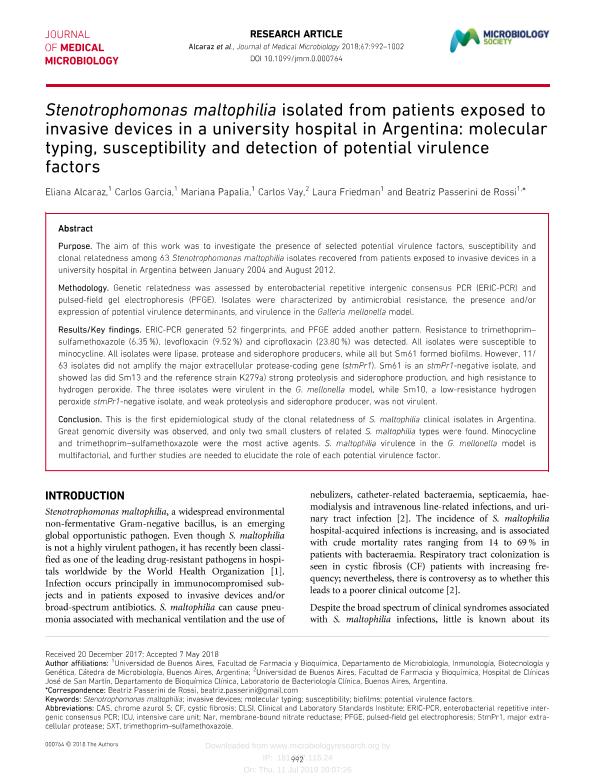Mostrar el registro sencillo del ítem
dc.contributor.author
Alcaraz, Eliana
dc.contributor.author
Garcia, Carlos
dc.contributor.author
Papalia, Mariana Andrea

dc.contributor.author
Vay, Carlos Alberto

dc.contributor.author
Friedman, Laura
dc.contributor.author
De Rossi, Beatriz Passerini
dc.date.available
2020-03-10T19:04:29Z
dc.date.issued
2018-07
dc.identifier.citation
Alcaraz, Eliana; Garcia, Carlos; Papalia, Mariana Andrea; Vay, Carlos Alberto; Friedman, Laura; et al.; Stenotrophomonas maltophilia isolated from patients exposed to invasive devices in a university hospital in Argentina: Molecular typing, susceptibility and detection of potential virulence factors; Society for General Microbiology; Journal Of Medical Microbiology; 67; 7; 7-2018; 992-1002
dc.identifier.issn
0022-2615
dc.identifier.uri
http://hdl.handle.net/11336/99048
dc.description.abstract
Purpose. The aim of this work was to investigate the presence of selected potential virulence factors, susceptibility and clonal relatedness among 63 Stenotrophomonas maltophilia isolates recovered from patients exposed to invasive devices in a university hospital in Argentina between January 2004 and August 2012. Methodology. Genetic relatedness was assessed by enterobacterial repetitive intergenic consensus PCR (ERIC-PCR) and pulsed-field gel electrophoresis (PFGE). Isolates were characterized by antimicrobial resistance, the presence and/or expression of potential virulence determinants, and virulence in the Galleria mellonella model. Results/Key findings. ERIC-PCR generated 52 fingerprints, and PFGE added another pattern. Resistance to trimethoprim– sulfamethoxazole (6.35 %), levofloxacin (9.52 %) and ciprofloxacin (23.80 %) was detected. All isolates were susceptible to minocycline. All isolates were lipase, protease and siderophore producers, while all but Sm61 formed biofilms. However, 11/ 63 isolates did not amplify the major extracellular protease-coding gene (stmPr1). Sm61 is an stmPr1-negative isolate, and showed (as did Sm13 and the reference strain K279a) strong proteolysis and siderophore production, and high resistance to hydrogen peroxide. The three isolates were virulent in the G. mellonella model, while Sm10, a low-resistance hydrogen peroxide stmPr1-negative isolate, and weak proteolysis and siderophore producer, was not virulent. Conclusion. This is the first epidemiological study of the clonal relatedness of S. maltophilia clinical isolates in Argentina. Great genomic diversity was observed, and only two small clusters of related S. maltophilia types were found. Minocycline and trimethoprim–sulfamethoxazole were the most active agents. S. maltophilia virulence in the G. mellonella model is multifactorial, and further studies are needed to elucidate the role of each potential virulence factor.
dc.format
application/pdf
dc.language.iso
eng
dc.publisher
Society for General Microbiology

dc.rights
info:eu-repo/semantics/openAccess
dc.rights.uri
https://creativecommons.org/licenses/by-nc-sa/2.5/ar/
dc.subject
BIOFILMS
dc.subject
INVASIVE DEVICES
dc.subject
MOLECULAR TYPING
dc.subject
POTENTIAL VIRULENCE FACTORS
dc.subject
STENOTROPHOMONAS MALTOPHILIA
dc.subject
SUSCEPTIBILITY
dc.subject.classification
Biología Celular, Microbiología

dc.subject.classification
Ciencias Biológicas

dc.subject.classification
CIENCIAS NATURALES Y EXACTAS

dc.title
Stenotrophomonas maltophilia isolated from patients exposed to invasive devices in a university hospital in Argentina: Molecular typing, susceptibility and detection of potential virulence factors
dc.type
info:eu-repo/semantics/article
dc.type
info:ar-repo/semantics/artículo
dc.type
info:eu-repo/semantics/publishedVersion
dc.date.updated
2020-03-05T14:57:12Z
dc.journal.volume
67
dc.journal.number
7
dc.journal.pagination
992-1002
dc.journal.pais
Reino Unido

dc.journal.ciudad
Londres
dc.description.fil
Fil: Alcaraz, Eliana. Universidad de Buenos Aires. Facultad de Farmacia y Bioquímica. Departamento de Microbiología, Inmunología y Biotecnología. Cátedra de Microbiología; Argentina
dc.description.fil
Fil: Garcia, Carlos. Universidad de Buenos Aires. Facultad de Farmacia y Bioquímica. Departamento de Microbiología, Inmunología y Biotecnología. Cátedra de Microbiología; Argentina
dc.description.fil
Fil: Papalia, Mariana Andrea. Universidad de Buenos Aires. Facultad de Farmacia y Bioquímica. Departamento de Microbiología, Inmunología y Biotecnología. Cátedra de Microbiología; Argentina. Consejo Nacional de Investigaciones Científicas y Técnicas; Argentina
dc.description.fil
Fil: Vay, Carlos Alberto. Universidad de Buenos Aires. Facultad de Medicina. Hospital de Clínicas General San Martín; Argentina. Consejo Nacional de Investigaciones Científicas y Técnicas; Argentina
dc.description.fil
Fil: Friedman, Laura. Universidad de Buenos Aires. Facultad de Farmacia y Bioquímica. Departamento de Microbiología, Inmunología y Biotecnología. Cátedra de Microbiología; Argentina
dc.description.fil
Fil: De Rossi, Beatriz Passerini. Universidad de Buenos Aires. Facultad de Farmacia y Bioquímica. Departamento de Microbiología, Inmunología y Biotecnología. Cátedra de Microbiología; Argentina
dc.journal.title
Journal Of Medical Microbiology

dc.relation.alternativeid
info:eu-repo/semantics/altIdentifier/url/https://www.microbiologyresearch.org/content/journal/jmm/10.1099/jmm.0.000764#tab2
dc.relation.alternativeid
info:eu-repo/semantics/altIdentifier/doi/http://dx.doi.org/10.1099/jmm.0.000764
Archivos asociados
